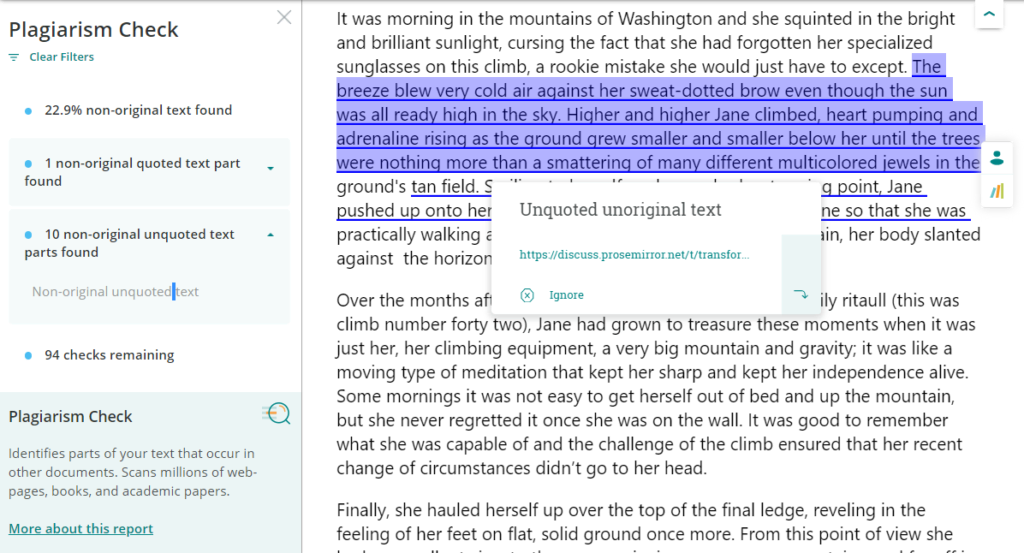What is self-plagiarism? This form of plagiarism can hurt many students, making it an important concept to understand.
In a world where anyone can publish a blog post at the click of a button, more and more writers run into problems with self-plagiarism. What is self-plagiarism, and is it something to avoid?
To understand whether or not this is a problem, especially as it relates to academic integrity, you must first understand this type of plagiarism and how to avoid it.
Contents
- What Is Self-Plagiarism? A Common Problem with a Simple Definition
- The Ethics of Self-Plagiarism in Academia and Research
- The Ethics of Self-Plagiarism with Publications
- Examples of Self-Plagiarism
- The Consequences of Self-Plagiarism
- How to Avoid Self-Plagiarism
- A Final Word on What Is Self-Plagiarism
- FAQs on What Is Self-Plagiarism
What Is Self-Plagiarism? A Common Problem with a Simple Definition

Self-plagiarism occurs when a writer uses their past works to publish something apparently new. It’s a problem typically found in academia.
The American Psychological Association defines self-plagiarism as: “the presentation of your own previously published work as original.” In other words, this type of plagiarism occurs when the author quotes or uses ideas from previous works without citing themselves correctly.
The Ethics of Self-Plagiarism in Academia and Research
This situation leads to an ethical dilemma. Many authors argue it’s not an issue because they own the copyright on the original work.
The APA disagrees. They say, “Self-plagiarism deceives readers by making it appear that more information is available on a topic than currently exists. It gives the impression that findings are more replicable than is the case.”
Keep in mind that the author does not have to quote their own words to be guilty. Paraphrasing something from earlier work and putting it into a new work, without proper citation counts as self-plagiarism in many academic publishing and academic research situations.
The Ethics of Self-Plagiarism with Publications
Outside of academia or research work, self-plagiarism can create copyright infringement issues when the published work has protections through the publishing company. Duplicate publication of the same work is an ethical issue and may break a publication agreement. Reusing work and publishing it with more than one publisher creates problems for the publishers who wish to have sole publication rights for the information.
Examples of Self-Plagiarism

There are many types of self-plagiarism to avoid if you value ethical writing. Here are some examples:
- Tweaking an older paper you wrote and resubmitting it for a new course. This form of self-plagiarism gets the writer out of some work that should be part of the education experience.
- Submitting a project from a previous class to fulfill the requirements of a new class. Again, this strategy tries to get out of work while passing the work off as a new paper.
- Augmented publication occurs when a writer submits work for publication with previously published content that has no proper citation. Even if the content is the author’s original work, it needs citation if it has a previous publication.
- Salami-slicing plagiarism occurs when a large body of research is sliced up into as many papers and reports as possible. Academic research considers this to be scientific misconduct and would prefer that the researcher publish all the work at one time.
- Text recycling is a form of self-plagiarism that occurs when a writer uses a previous publication and paraphrases all or most of it to create a new research paper or publication.
- Redundant publication occurs when the same body of research is the basis for multiple submissions or publications.
The Consequences of Self-Plagiarism
Self-plagiarism has several potential consequences. The research community considers it a form of research misconduct, which can discredit the individual’s entire body of work. Citation errors, including lack of citation of a writer’s work, can prevent researchers from publishing their work.
In the academic world, if professors discover self-plagiarism, a student could receive a lower or failing grade. More commonly, the instructor could require the work to be redone.
Finally, self-plagiarism can put an author in breach of publication contracts for published work. All of these consequences cause the writer’s reputation to be damaged, which makes avoiding self-plagiarism important.
Learn more about the consequences of plagiarism.
How to Avoid Self-Plagiarism
To avoid self-plagiarism, consider these tips:
- Review your existing work before publishing something new.
- Do not reuse data from one research project to another.
- Cite anything you quote or use in your new publication, even if it is your old work.
- Use tools like TurnItIn.com’s iThenticate or REF-N-WRITE to check work for plagiarism.
- Get permission from co-authors or publishers if citing or using old research for your new work.
A Final Word on What Is Self-Plagiarism
Self-Plagiarism is a serious ethical issue that occurs when you use previously published work as a new work. This problem occurs commonly in academic and research settings but can also occur in regular publications.
Plagiarising your work is considered an ethical mistake. It violates publication contracts and makes research look better than it is. To avoid this, carefully cite all work, even your work, when writing something new. Rewrite and update the central idea and arguments, so your latest work is distinct from past works too. If in doubt, use a good plagiarism checker
FAQs on What Is Self-Plagiarism
How to avoid self-plagiarism?
The best way to avoid self-plagiarism is to write new, original works with fresh research. If you need to quote something you’ve already written, use proper citations to clarify the data is already published.
Is self-plagiarism considered a form of cheating?
Self-plagiarism is considered unethical in both academic and research settings. Most schools consider it a form of cheating as the author tries to get out of some work to publish a paper that includes work already done.